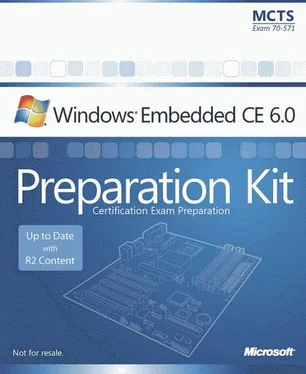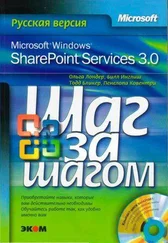Nicolas Besson - Microsoft Windows Embedded CE 6.0 Exam Preparation Kit
Здесь есть возможность читать онлайн «Nicolas Besson - Microsoft Windows Embedded CE 6.0 Exam Preparation Kit» весь текст электронной книги совершенно бесплатно (целиком полную версию без сокращений). В некоторых случаях можно слушать аудио, скачать через торрент в формате fb2 и присутствует краткое содержание. Город: Redmond, Год выпуска: 2008, Издательство: Microsoft, Жанр: Руководства, ОС и Сети, Программы, на английском языке. Описание произведения, (предисловие) а так же отзывы посетителей доступны на портале библиотеки ЛибКат.
- Название:Microsoft Windows Embedded CE 6.0 Exam Preparation Kit
- Автор:
- Издательство:Microsoft
- Жанр:
- Год:2008
- Город:Redmond
- ISBN:нет данных
- Рейтинг книги:5 / 5. Голосов: 1
-
Избранное:Добавить в избранное
- Отзывы:
-
Ваша оценка:
- 100
- 1
- 2
- 3
- 4
- 5
Microsoft Windows Embedded CE 6.0 Exam Preparation Kit: краткое содержание, описание и аннотация
Предлагаем к чтению аннотацию, описание, краткое содержание или предисловие (зависит от того, что написал сам автор книги «Microsoft Windows Embedded CE 6.0 Exam Preparation Kit»). Если вы не нашли необходимую информацию о книге — напишите в комментариях, мы постараемся отыскать её.
Microsoft Windows Embedded CE 6.0 Exam Preparation Kit — читать онлайн бесплатно полную книгу (весь текст) целиком
Ниже представлен текст книги, разбитый по страницам. Система сохранения места последней прочитанной страницы, позволяет с удобством читать онлайн бесплатно книгу «Microsoft Windows Embedded CE 6.0 Exam Preparation Kit», без необходимости каждый раз заново искать на чём Вы остановились. Поставьте закладку, и сможете в любой момент перейти на страницу, на которой закончили чтение.
Интервал:
Закладка:
1. During the boot process, the kernel calls the OEMInit function in the OAL to register all available ISRs built into the kernel with their corresponding hardware interrupts based on their interrupt request (IRQ) values. IRQ values are numbers that identify the source of the interrupt in the processor interrupt controller registers.<\/p>
2. Device drivers can dynamically install ISRs implemented in ISR DLLs by calling the LoadIntChainHandler function. LoadIntChainHandler loads the ISR DLL into kernel memory space and registers the specified ISR routine with the specified IRQ value in the kernel's interrupt dispatch table.<\/p>
3. An interrupt occurs to notify the CPU that an event requires suspending the current thread of execution and transferring control to a different routine.<\/p>
4. In response to the interrupt, the CPU stops executing the current thread and jumps to the kernel exception handler as the primary target of all interrupts.<\/p>
5. The exception handler masks off all interrupts of an equal or lower priority and then calls the appropriate ISR registered to handle the current interrupt. Most hardware platforms use interrupt masks and interrupt priorities to implement hardware-based interrupt synchronization mechanisms.<\/p>
6. The ISR performs any necessary tasks, such as masking the current interrupt so that the current hardware device cannot trigger further interrupts, which would interfere with the current processing, and then returns a SYSINTR value to the exception handler. The SYSINTR value is a logical interrupt identifier.<\/p>
7. The exception handler passes the SYSINTR value to the kernel's interrupt support handler, which determines the event for the SYSINTR value, and, if found, signals that event for any waiting ISTs for the interrupt.<\/p>
8. The interrupt support handler unmasks all interrupts, with the exception of the interrupt currently in processing. Keeping the current interrupt masked off explicitly prevents the current hardware device from triggering another interrupt while the IST runs.<\/p>
9. The IST runs in response to the signaled event to perform and finish the interrupt handling without blocking other devices on the system.<\/p>
10. The IST calls the InterruptDone function to inform the kernel's interrupt support handler that the IST has finished its processing and is ready for another interrupt event.<\/p>
11. The interrupt support handler calls the OEMInterruptDone function in the OAL to complete the interrupt handling process and reenable the interrupt.<\/p>
Interrupt Service Routines<\/p> <\/div>
In general, ISRs are small blocks of code that run in response to a hardware interrupt. Because the kernel exception handler masks off all interrupts of equal or lesser priority while this ISR runs, it is important to complete the ISR and return a SYSINTR value as quickly as possible so that the kernel can re-enable (unmask) all IRQs with minimal delay (except the currently processed interrupt). System performance can suffer significantly if too much time is spent in ISRs, leading to missed interrupts or overrun buffers on some devices. Another important aspect is that the ISR runs in kernel mode and does not have access to higher-level operating system APIs. For these reasons, ISRs usually perform no more than the most basic tasks, such as quickly copying data from hardware registers to memory buffers. On Windows Embedded CE, time-consuming interrupt processing is usually performed in an IST.<\/p>
The primary task of the ISR is to determine the interrupt source, mask off or clear the interrupt at the device, and then return a SYSINTR value for the interrupt to notify the kernel about an IST to run. In the simplest case, the ISR returns SYSINTR_NOP to indicate that no further processing is necessary. Accordingly, the kernel does not signal an event for an IST to handle the interrupt. On the other hand, if the device driver uses an IST to handle the interrupt, the ISR passes the logical interrupt identifier to the kernel, the kernel determines and signals the interrupt event, and the IST typically resumes from a WaitForSingleObject call and executes the interrupt processing instructions in a loop. The latency between the ISR and the IST depends on the priority of the thread and other threads running in the system, as explained in Chapter 3, "Performing System Programming." Typically, ISTs run with a high thread priority.<\/p>
Interrupt Service Threads<\/p> <\/div>
An IST is a regular thread that performs additional processing in response to an interrupt, after the ISR has completed. The IST function typically includes a loop and a WaitForSingleObject call to block the thread infinitely until the kernel signals the specified IST event, as illustrated in the following code snippet. However, before you can use the IST event, you must call InterruptInitialize with the SYSINTR value and an event handle as parameters so that the CE kernel can signal this event whenever an ISR returns the SYSINTR value. Chapter 3 provides detailed information about multithreaded programming and thread synchronization based on events and other kernel objects.<\/p>
CeSetThreadPriority(GetCurrentThread(), 200);<\/code> <\/p>
// Loop until told to stop<\/code> <\/p>
while(!pIst->stop) {<\/code> <\/p>
// Wait for the IST event.<\/code> <\/p>
WaitForSingleObject(pIst->hevIrq, INFINITE)<\/code> <\/p>
// Handle the interrupt.<\/code> <\/p>
InterruptDone(pIst->sysIntr);<\/code> <\/p>
}<\/code> <\/p>
When the IST has completed processing an IRQ, it should call InterruptDone to inform the system that the interrupt was processed, that the IST is ready to handle the next IRQ, and that the interrupt can be reenabled by means of an OEMInterruptDone call. Table 6-6 lists the OAL functions that the system uses to interact with the interrupt controller to manage interrupts.<\/p>
Table 6-6 OAL functions for interrupt management<\/strong> <\/p>
| Function<\/th> | Description<\/th> <\/tr> |
|---|---|
| OEMInterruptEnable<\/td> | This function is called by the kernel in response to InterruptInitialize and enables the specified interrupt in the interrupt controller.<\/td> <\/tr> |
| OEMInterruptDone<\/td> | This function is called by the kernel in response to InterruptDone and should unmask the interrupt and acknowledge the interrupt in the interrupt controller.<\/td> <\/tr> |
| OEMInterruptDisable<\/td> | This function disables the interrupt in the interrupt controller and is called in response to the InterruptDisable function.<\/td> <\/tr> |
| OEMInterruptHandler<\/td> | For ARM processors only, this function identifies the interrupt SYSINTR that occurs by looking at the status of the interrupt controller.<\/td> <\/tr> |
| HookInterrupt<\/td> | For processors other than ARM, this function registers a callback function for a specified interrupt ID. This function must be called in the OEMInit function to register mandatory interrupts.<\/td> <\/tr> |
| OEMInterruptHandlerFIQ<\/td> | For ARM processors, used to handle interrupts for the Fast Interrupt (FIQ) line.<\/td> <\/tr> <\/table>
CAUTION<\/div>
WaitForMultipleObjects restriction<\/div>
Do not use the WaitForMultipleObjects function to wait for an interrupt event. If you must wait for multiple interrupt events, you should create an IST for each interrupt.<\/p> <\/cite> |
Интервал:
Закладка:
Похожие книги на «Microsoft Windows Embedded CE 6.0 Exam Preparation Kit»
Представляем Вашему вниманию похожие книги на «Microsoft Windows Embedded CE 6.0 Exam Preparation Kit» списком для выбора. Мы отобрали схожую по названию и смыслу литературу в надежде предоставить читателям больше вариантов отыскать новые, интересные, ещё непрочитанные произведения.
Обсуждение, отзывы о книге «Microsoft Windows Embedded CE 6.0 Exam Preparation Kit» и просто собственные мнения читателей. Оставьте ваши комментарии, напишите, что Вы думаете о произведении, его смысле или главных героях. Укажите что конкретно понравилось, а что нет, и почему Вы так считаете.








